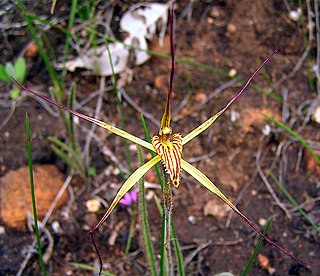
Caladenia, commonly known as spider orchids, is a genus of 350 species of plants in the orchid family, Orchidaceae. Spider orchids are terrestrial herbs with a single hairy leaf and a hairy stem. The labellum is fringed or toothed in most species and there are small projections called calli on the labellum. The flowers have adaptations to attract particular species of insects for pollination. The genus is divided into three groups on the basis of flower shape, broadly, spider orchids, zebra orchids and cowslip orchids, although other common names are often used. Although they occur in other countries, most are Australian and 136 species occur in Western Australia, making it the most species-rich orchid genus in that state.

Caladenia angustata, commonly known as white caps is a species of orchid endemic to Tasmania. It has a single, hairy leaf and one or two white to pinkish flowers which are reddish or greenish on their backs. It has not been accepted as a separate species by some authorities who regard it as a synonym of Caladenia gracilis.

Caladenia latifolia, commonly known as pink fairies is a species of orchid endemic to Australia and is common and widespread in the southern half of the continent and in Tasmania. It has a single, hairy leaf and up to four pink flowers. It is easily distinguished by its relatively large, green leaf, and pink flowers on an unusually tall spike.

Caladenia arenicola, commonly known as the carousel spider orchid, is a plant in the orchid family Orchidaceae and is endemic to the south-west of Western Australia. It has a single erect, hairy leaf and up to three red, white and green flowers on a flowering stem up to 60 cm (20 in) high. It is a common species on the Swan Coastal Plain, where it grows in sandy soil under trees.

Caladenia dilatata, commonly known as the green-comb spider-orchid and as koolin by Aboriginal people of the Coranderrk area, is species of flowering plant in the family Orchidaceae and is endemic to south-eastern Australia. It has a single leaf and a single yellowish-green flower with reddish stripes and occurs in Victoria South Australia and Tasmania. It is similar to C. necrophylla which occurs in south-east South Australia and to C. concinna from southern New South Wales.

Diuris laxiflora, commonly called the banded bee orchid or bee orchid is a species of orchid which is endemic to Western Australia. It is a small orchid, common within its range and about half the size of the common donkey orchid, Diuris corymbosa.
Caladenia abbreviata, commonly known as the coastal spider orchid, is a plant in the orchid family Orchidaceae and is endemic to the south-west of Western Australia. It has a single erect, hairy leaf and up to three pale, creamy-yellow flowers on a flowering stem up to 35 cm (10 in) high. Although the flowers have long, thread-like petals and sepals, they are shorter and darker than those of other spider orchids. It is a rare, relatively recently discovered species although often found near human activities.

Caladenia brevisura, commonly known as the short-sepalled spider orchid, is a plant in the orchid family Orchidaceae and is endemic to the south-west of Western Australia. It is a common, small-flowered orchid with an erect, hairy leaf and a single greenish flower with red markings, on a flowering stem up to 25 cm (10 in) high. It is found between Ravensthorpe and Israelite Bay.

Caladenia caesarea subsp. caesarea, commonly known as the mustard spider orchid, is a plant in the orchid family Orchidaceae and is endemic to the south-west of Western Australia. It has a single spreading, hairy leaf and up to three mustard-coloured flowers with red stripes. It was originally described as a subspecies of Caladenia filamentosa but the rich colour of its flowers and prominent labellum separate it from that species.

Caladenia filamentosa, commonly known as daddy-long-legs, is a plant in the orchid family Orchidaceae and is endemic to eastern Australia. It is a ground orchid with a single hairy leaf and up to four, usually dark red flowers with long, drooping lateral sepals and petals.
Caladenia leptochila subsp. dentata, commonly known as the toothed spider orchid, narrow-lipped spider-orchid or narrow-lipped caladenia, is a plant in the orchid family Orchidaceae and is endemic to South Australia. It has a single leaf and one or two mostly reddish-brown flowers. It differs from subspecies leptochila in the colour of its flowers, toothed edges to its labellum, and its distribution.

Caladenia leptochila subsp. leptochila, commonly known as the narrow-lipped spider orchid, is a plant in the orchid family Orchidaceae and is endemic to South Australia. It has a single leaf and one or two yellowish or red flowers. It differs from subspecies leptochila in the colour of its flowers, lack of toothed edges to its labellum, and its distribution.

Caladenia stricta, commonly known as the upright spider orchid or rigid-combed spider-orchid is a plant in the orchid family Orchidaceae and is endemic to southern continental Australia. It is a ground orchid with a single leaf and usually only one pale green flower with red lines along the sepals and petals.
Caladenia saxatilis is a plant in the orchid family Orchidaceae and is endemic to South Australia. It is a ground orchid with a single hairy leaf and one or two pale creamy-green flowers, sometimes with thin reddish lines. It occurs in the southern Flinders Ranges.
Caladenia aurulenta is a plant in the orchid family Orchidaceae and is endemic to South Australia. It was first formally described in 2005 by David Jones, who gave it the name Arachnorchis aurulenta and published the description in The Orchadian from a specimen collected in the Gawler Ranges. In 2008, Robert Bates changed the name to Caladenia aurulenta. The specific epithet (aurulenta) is a Latin word meaning "golden", "made of gold" or "ornamented with gold". Caladenia aurulenta occurs in the northern part of the Eyre Peninsula.
Caladenia interanea, commonly known as the inland spider orchid, is a plant in the orchid family Orchidaceae and is endemic to the Eyre Peninsula in South Australia. It is a ground orchid with a single hairy leaf and a single green flower with dark red stripes.

Caladenia major, commonly known as the waxlip orchid, parson-in-the-pulpit, or purple cockatoo is a plant in the orchid family Orchidaceae, and is endemic to Australia. It is a ground orchid with a single hairy leaf and one or two purple to mauve flowers. It has been known as Glossodia major since its description by the prolific Scottish botanist Robert Brown in 1810, but recent discoveries suggest its inclusion in the genus Caladenia.

Caladenia emarginata, commonly known as the pink enamel orchid, is a plant in the orchid family Orchidaceae and is endemic to the south-west of Western Australia. It is a ground orchid with a single flattened, hairy leaf and up to four glossy pink flowers. It is similar to Caladenia brunonis but is usually a shorter plant but with larger, pink flowers. It has been known as Elythranthera emarginata since 1963 but recent discoveries suggest its inclusion in the genus Caladenia.
Caladenia fuliginosa is a plant in the orchid family Orchidaceae and is endemic to the Yorke Peninsula in South Australia. It is a ground orchid with a single hairy leaf and a single relatively large, creamy-yellow flower, sometimes with reddish lines. The flowers have a smell resembling hot metal.
Robert J. "Rob" Bates is an Australian botanist, plant collector, and illustrator.












